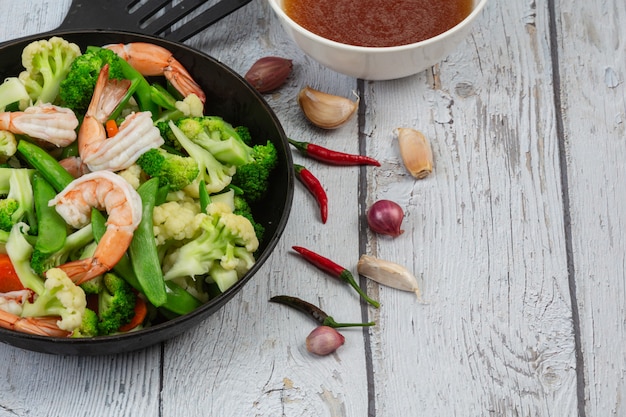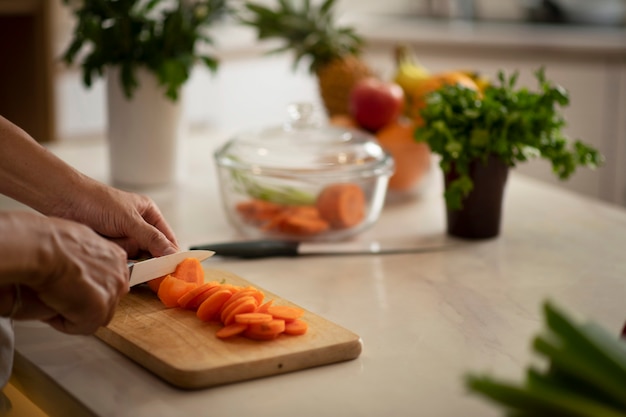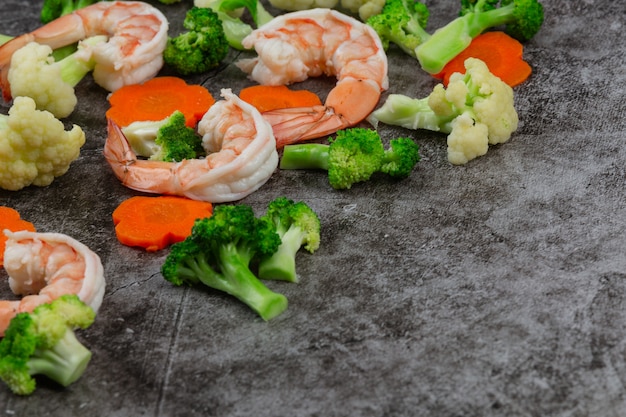Let's be honest, a good shrimp salad is a thing of beauty. Fresh, light, and packed with protein – it's a winner in my book. But nothing ruins a salad faster than tough, rubbery shrimp. I've been there – it's a total culinary tragedy. So, I've dedicated myself to finding the perfect way to cook shrimp for salads, and let me tell you, it's a game-changer.
This guide is your ultimate roadmap to shrimp salad success, covering everything from picking the perfect shrimp to nailing those cooking techniques. I'm sharing all my tips and tricks, the ones I've learned over years of experimenting in the kitchen. We'll cover both the basics and more advanced techniques, ensuring you can confidently whip up delicious salads with perfectly cooked shrimp, every single time.
(Part 1) Picking the Perfect Shrimp: It All Starts Here

Choosing the Right Size: Finding Your Sweet Spot
First things first, you need to choose the right kind of shrimp. For salads, I always go for medium-sized shrimp, typically a 16/20 count. This means there are around 16 to 20 shrimp per pound, offering a good balance of size and texture. They're big enough to be satisfying but not so large that they become tough. Smaller shrimp (like 21/25 count) can get lost in the salad, while larger shrimp (like 8/12 count) can be a bit chewy.
Fresh vs. Frozen: The Great Debate
Now, the big question: fresh or frozen? Personally, I'm a fan of both. fresh shrimp is a treat, especially when you can get it from a local fishmonger. But let's face it, frozen shrimp is just as good, super convenient, and usually cheaper. Just make sure to thaw it properly in the refrigerator overnight – absolutely no microwaving!
Raw vs. Pre-Cooked: The Versatility Factor
If you go for fresh, you have two options: raw or pre-cooked. Raw shrimp offers more versatility – you can cook it any way you like. Pre-cooked shrimp, on the other hand, is a time-saver and perfect for salads where you're not planning to cook anything else. Just remember to give it a quick sauté or grill to warm it up and enhance the flavor.
(Part 2) The Art of shrimp preparation: Getting Ready to Cook

Once you've got your shrimp, it's time to get prepped. This is where the magic truly begins!
Deveining: A Matter of Taste
Some folks swear by deveining shrimp, claiming it makes them look more elegant. I find it's more about personal preference. It doesn't bother me at all. You'll find lots of opinions online, so just do what feels right for you.
To devein, use a small, sharp knife to make a cut down the back of the shrimp. Gently remove the dark vein, which runs along the back. Be careful not to cut too deep, or you'll lose some of the precious shrimp meat.
Cleaning: Essential for a Delicious Outcome
Cleaning is a crucial step – it involves removing the digestive tract from the shrimp. Simply rinse them under cold water and gently peel off the outer shell. Don't remove the tail – it's important for presentation. If you're using frozen shrimp, make sure it's fully thawed before cleaning.
Marination Magic: Flavour-Boosting Techniques
Here comes the fun part – marinating! This is your opportunity to make your shrimp truly sing. I love to marinate my shrimp in a simple mixture of olive oil, lemon juice, garlic, and herbs. It gives the shrimp a lovely bright flavor and adds a touch of zest to the salad.
Feeling adventurous? Try different marinades:
Citrus: Orange juice, lime juice, and ginger for a tangy twist.
Mediterranean: Olive oil, red wine vinegar, oregano, and rosemary for a classic taste.
The key is to marinate your shrimp for at least 30 minutes, preferably a couple of hours. This lets the flavors penetrate deeply, creating a more intense taste experience.
(Part 3) Cooking Methods for Salad-Worthy Shrimp: Perfecting Your Technique

1. The Classic Sauté: Quick and Easy, Always a Winner
This is my go-to method for everyday shrimp salads. It's quick, easy, and produces perfectly cooked shrimp. Simply heat a little olive oil in a skillet over medium heat, then add the shrimp. Cook for 2 to 3 minutes per side, or until they're pink and opaque. Don't overcook them, or they'll become tough.
2. The Grill Master: Smoky and Delicious, For a Touch of Char
If you're looking for a more intense flavor, grilling is the way to go. Preheat your grill to medium heat, then thread the shrimp onto skewers. Grill for 2 to 3 minutes per side, or until they're cooked through. You can brush them with a marinade while they're cooking, or add a sprinkle of paprika for a touch of spice.
3. The Pan-Seared Prowess: Crispy and Delightful, For a Flavorful Crust
For a crispy, caramelized exterior, pan-searing is the perfect choice. Heat a tablespoon of olive oil in a cast iron skillet over medium-high heat. Once the oil is shimmering, add the shrimp and cook for 1 to 2 minutes per side, or until golden brown and cooked through. This method really brings out the natural flavor of the shrimp.
4. The Baking Bonanza: Oven-Friendly Option, When Time is on Your Side
If you're looking for a hands-off approach, baking is the way to go. Preheat your oven to 400°F (200°C). Line a baking sheet with parchment paper, then toss the shrimp with a drizzle of olive oil, salt, and pepper. Bake for 8 to 10 minutes, or until the shrimp are cooked through. This is great for larger batches of shrimp.
5. The Poaching Perfection: Gentle and Delicate, For a Subtly Flavorful Shrimp
For a gentle, flavor-enhancing method, poaching is the best choice. Bring a pot of water to a simmer, then add the shrimp, salt, and pepper. Cook for 2 to 3 minutes, or until the shrimp turn pink. This method is ideal for delicate shrimp that need a gentle touch.
(Part 4) The Ultimate Guide to Perfect shrimp texture: A Lesson in Timing
The Key: Knowing When It's Done, To Avoid Disaster
You'll know your shrimp are perfectly cooked when they're pink and opaque throughout. The flesh should be firm but not tough. You can also test the shrimp by poking them with a fork. If they bounce back, they're cooked through.
Overcooked Shrimp: A Culinary Tragedy, Avoiding Toughness
Overcooked shrimp is a culinary disaster. It becomes rubbery, dry, and loses its delicate flavor. Remember: It's better to err on the side of undercooked than overcooked. You can always give them a little extra time in the pan if you're unsure.
Undercooked Shrimp: A Health Hazard, Ensuring Safety
Undercooked shrimp is a serious health hazard. It can harbor bacteria that can cause food poisoning. Ensure you cook your shrimp thoroughly to avoid any unpleasant surprises.
(Part 5) The Right Way to Store Cooked Shrimp: Maintaining Freshness
Refrigeration Rules: Keeping Shrimp Delicious
Once your shrimp are cooked, it's important to store them properly to maintain their freshness. I always refrigerate cooked shrimp in an airtight container. I find that storing them in a single layer helps to prevent them from sticking together.
Freezing for Later: Making Sure It's Ready When You Are
If you're not planning on using your shrimp immediately, you can freeze them for later. I recommend freezing cooked shrimp in a single layer on a baking sheet lined with parchment paper. Once frozen, you can transfer them to a freezer-safe bag. This prevents them from sticking together.
Thawing Tips: Avoiding Texture Issues
When you're ready to use your frozen shrimp, thaw them in the refrigerator overnight. Never thaw them at room temperature or in the microwave – this can compromise the texture and flavor.
(Part 6) Tips for Using Shrimp in Salads: Elevate Your Dish
Adding the Shrimp: Timing is Everything
Once your shrimp are cooked and cooled, it's time to add them to your salad. I like to add the shrimp to my salads just before serving. This helps to keep the shrimp fresh and prevents them from getting soggy.
Choosing the Salad Base: A Foundation for Flavor
For a light and refreshing salad, I love to use mixed greens, spinach, or arugula. But you can also use romaine lettuce, kale, or even quinoa for a more hearty salad.
Adding Flavor: The Art of Balance
To complement the shrimp, I love to add fresh herbs, crunchy vegetables, and a flavorful dressing. Some of my favorite combinations include:
Mediterranean: Olives, tomatoes, cucumbers, red onion, feta cheese, and a lemon vinaigrette.
Asian: Shredded carrots, snap peas, bell peppers, cilantro, and a sesame-ginger dressing.
Cajun: Corn, black beans, red bell peppers, and a spicy Cajun dressing.
Experimenting with Other Ingredients: Breaking the Rules
Don't be afraid to experiment with other ingredients. Avocado, mango, pineapple, and even roasted sweet potatoes can add delicious flavor and texture to your shrimp salad.
(Part 7) FAQs: Common Questions, Clear Answers
1. What is the best way to prevent shrimp from getting rubbery?
The key is to not overcook them. Shrimp should be cooked until they are just pink and opaque, about 2-3 minutes per side. Overcooking will make them tough and rubbery.
2. Can I use frozen shrimp in a salad?
Absolutely! Just make sure to thaw the shrimp in the refrigerator overnight before using them.
3. Can I cook shrimp ahead of time?
Yes, you can cook shrimp ahead of time and store them in the refrigerator for up to 3 days. Just make sure to refrigerate them in an airtight container.
4. How do I know if shrimp is cooked?
Cooked shrimp will be pink and opaque throughout. The flesh should be firm but not tough. You can also test them by poking them with a fork. If they bounce back, they’re cooked through.
5. What are some creative ways to use cooked shrimp in a salad?
You can add shrimp to any type of salad! Try using them in a Caesar salad, a Greek salad, a Cobb salad, or even a pasta salad. You can also make a delicious shrimp salad sandwich or wrap.
(Part 8) Shrimp Salad Recipes: A Taste of Inspiration
1. The Classic Shrimp Salad: A Timeless Favorite
1 pound cooked shrimp
1/2 cup mayonnaise
1/4 cup celery, finely chopped
1/4 cup red onion, finely chopped
1 tablespoon lemon juice
1 teaspoon Dijon mustard
Salt and pepper to taste
Combine all ingredients in a bowl and mix well. Serve on a bed of mixed greens.
2. The Spicy Shrimp Salad: A Touch of Heat
1 pound cooked shrimp
1/2 cup mayonnaise
1/4 cup jalape??o pepper, finely chopped
1/4 cup red onion, finely chopped
1 tablespoon lime juice
1 teaspoon sriracha sauce
Salt and pepper to taste
Combine all ingredients in a bowl and mix well. Serve on a bed of arugula.
3. The Mediterranean Shrimp Salad: Fresh and Flavorful
1 pound cooked shrimp
1/2 cup chopped tomatoes
1/2 cup chopped cucumbers
1/4 cup kalamata olives
1/4 cup crumbled feta cheese
1 tablespoon red wine vinegar
1 tablespoon olive oil
Salt and pepper to taste
Combine all ingredients in a bowl and mix well. Serve on a bed of mixed greens.
4. The Asian Shrimp Salad: Sweet and Savory
1 pound cooked shrimp
1/2 cup shredded carrots
1/2 cup snap peas
1/4 cup bell peppers, finely chopped
1 tablespoon soy sauce
1 tablespoon rice vinegar
1 tablespoon sesame oil
1 teaspoon sesame seeds
Salt and pepper to taste
Combine all ingredients in a bowl and mix well. Serve on a bed of spinach.
(Part 9) Conclusion: A Culinary Victory, Shrimp Salad Mastery
There you have it, my friends: the ultimate guide to perfectly cooked shrimp for salads. With this guide in hand, you can confidently navigate the world of shrimp cooking and create delicious, flavor-packed salads that will impress your friends and family.
I hope you've enjoyed my insights and personal tips. Remember, the key is to have fun, experiment, and find what works best for you. And don't be afraid to try new things! Your shrimp salad journey is just beginning.
Everyone is watching

Prime Rib Roast Cooking Time Chart: Per Pound Guide
Cooking TipsPrime rib roast. Just the name conjures images of lavish dinners, crackling fires, and hearty laughter. It’s ...

How Long to Bake Potatoes in the Oven (Perfect Every Time)
Cooking TipsBaked potatoes are a staple in my kitchen. They're incredibly versatile, delicious, and surprisingly easy to m...

Perfect Rice Every Time: The Ultimate Guide to Cooking Rice
Cooking TipsAs a self-proclaimed foodie, I've always been a bit obsessed with rice. It's the foundation of countless cuisi...

The Ultimate Guide to Cooking Asparagus: Tips, Techniques, and Recipes
Cooking TipsAsparagus. The mere mention of this spring delicacy conjures up images of vibrant green spears, crisp and burs...

Ultimate Guide to Cooking the Perfect Thanksgiving Turkey
Cooking TipsThanksgiving. Just the word conjures up images of overflowing tables laden with delicious food, the scent of r...
